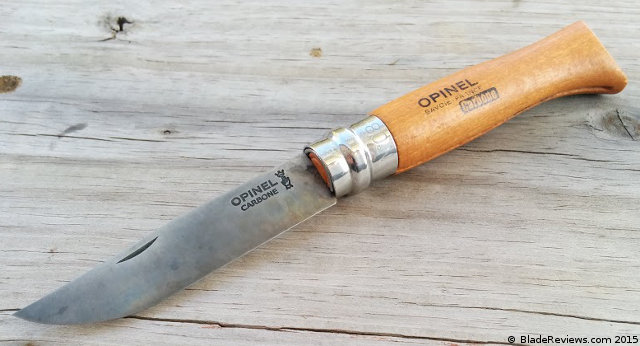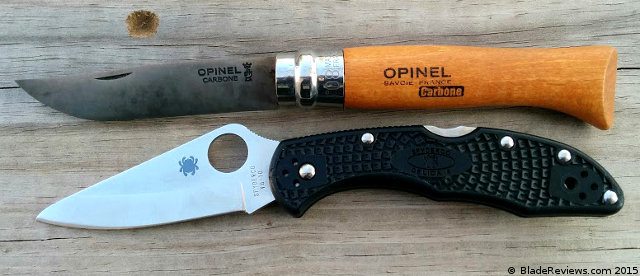Do you want to hear another “the knife that got me into knives story?” No? Alright, I’ll spare you and just say that, a few years ago, it was the lines and material of the Opinel knife that caught my eye when I was wandering around labyrinthine hardware store/Boulder landmark McGuckin’s, and to this day I’m still plummeting headfirst down the rabbit hole.
There are certain objects whose design is so complete that they have an innate, immediate appeal to the mind; the Opinel is such an object. And even now, years down the road, after many permutations in personal taste, I still carry and use my first real knife, the Opinel No. 8.
General Dimensions and Blade Details
The Opinel No. 8 is made in France. Each knife in the main Opinel line is given a number that is the approximate length of the blade in centimeters: the No. 8 is historically the most popular size. My No. 8 has a blade length of 3 3/16”, a handle length of 4 3/8”, and an overall length of 7 5/8”; it weighs just 1.6 oz.
The No. 8 is comprised of just five pieces: the blade, the wooden handle, a steel collar around the pivot, a pin to keep that collar in place, and the rotating Virobloc locking ring, which fits over the steel collar. It’s a hoary old quote, but since it’s from a French writer and we’re talking about a French knife, it seems appropriate: Antoine de St-Exupéry once said that “A designer knows he has achieved perfection not when there is nothing left to add, but when there is nothing left to take away.” The five parts of the Opinel are all integral to its function; a single addition would be superfluous, and a single subtraction would impact performance. The smaller Opinels (nos. 2-5) lack the Virobloc ring, but with a blade as large as the one on the No.8, I think the lock is necessary.
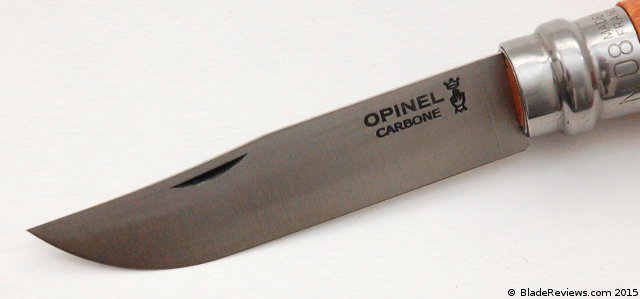
That blade is a beautiful, sweeping clip point, with a glorious full flat grind, unadorned save for a nail mark, the words “Opinel Carbone,” and the famous main couronnée logo stamped close to the pivot. The length of the No. 8 allows for excellent food-slicing capabilities; generally I don’t cut food with my pocket knives, but the ease with which the No. 8 does it is impressive. Beyond food prep, although it doesn’t look the part, the No. 8 can perform medium-duty EDC tasks like breaking down boxes with grace: I used it to cut up a ton of cardboard and, besides a white-hot blade, I had no issues. It is also wonderful for whittling. It has been said in a thousand different places, by myself and others, but simple blade shapes are the best, and the Opinel is a textbook example of this fact.
This is a carbon steel model, made from XC90 steel. This a soft, durable carbon steel, and like all carbon steels can rust easily. It also sharpens easily-easier than any other steel I’ve ever used, in fact, including the famously easy-to-sharpen Victorinox steel. XC90 responds to the stones with a plasticity that is shocking if you’re used to more ornery modern steels: the No. 8 will go from dull to super sharp in ten minutes. XC90’s softness also means that it recovers from abuse quite well, tending to roll instead of chip. It also means, of course, that it doesn’t stay sharp for all that long, but with how easy it is to put an edge back on I find it hard to complain.
I will say, though, that when I pick up another Opinel, I will opt for a stainless steel model. Opinel’s stainless steel of choice is 12C27N, an excellent steel, especially when you consider how inexpensive an Opinel is ($15ish), that will significantly lessen rust issues, as well as eliminate the weird taste carbon steel imparts to food (I’ve had my No. 8 for years and I still notice it). And it will still sharpen up readily when the time comes. Carbon steel has its place in the knife world, but in my opinion that place is in big fixed blades; on an EDC folding knife, I think it’s a suboptimal choice.
Handle, Ergonomics, and Carry
The standard Opinel handle material is wood, and the standard wood is Beech, which is (I believe, correct me if I’m wrong, woodsmen) what mine is made out of. It offers decent traction without any sort of gimping or other modern considerations. The handle is a sort of piscine shape, with a gentle curve instead of aggressive scalloping or finger grooves, and this, along with its round shape, make for an excellent knife in the hand. It’s really a ‘grip-neutral’ knife: it works equally well in all grips. The spine of the blade is flat, allowing for a place to put your thumb for extra control, and the flat butt-end of the knife creates a good spot for your thumb in a reverse grip.
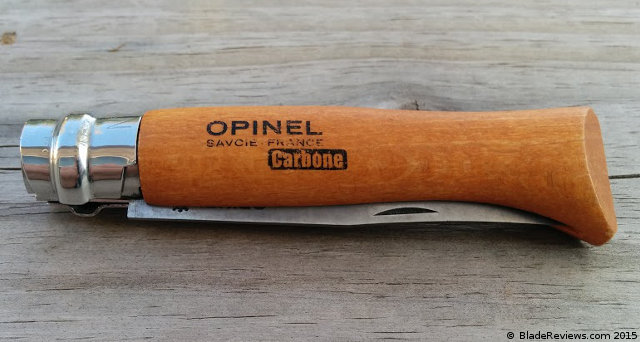
There is no clip, of course. And you probably knew this the minute you saw the knife, but its round, hand-filling shape, although great from an ergonomics perspective, is less than stellar in the pocket; this knife will take up quite a bit of room if you want to EDC it. I don’t have an issue with it, but I generally go pretty light on pocketables, so your experience may differ. The good news is that it is made out of durable materials and won’t get dinged or scratched up by your keys and other paraphernalia, and at 1.6 oz. is very light.
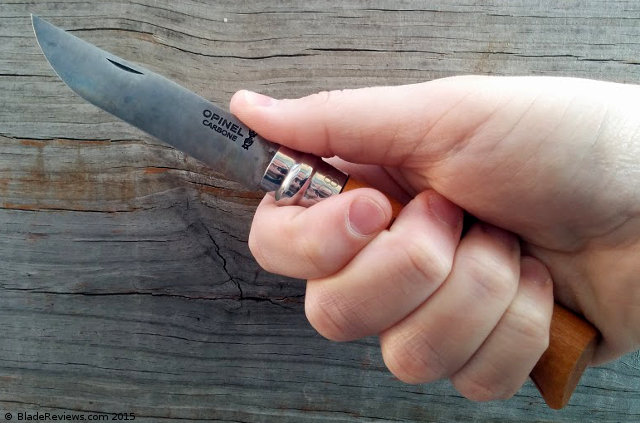
Deployment and Lockup
The nail mark tells you that this will be a two-hand-opening knife. I know that some two-hand knives (like the Pingo) can be kind of ‘cheesed’ into opening with one hand, but you’ll have no such luck with the Opinel No. 8: the blade buries deep in the handle, so there isn’t any place for your thumb to gain traction.
The good news is that the No. 8 is a smooth, effortless opener. Unlike a slipjoint, it has no spring putting tension on the blade, and so it comes out without a struggle; indeed, I rarely use the nail mark, instead just preferring to pinch the blade and pull. The only time I’ve had issues with it is when the wooden handle has swollen some; this creates some tightness, but it’s temporary and doesn’t render the knife unusable regardless.
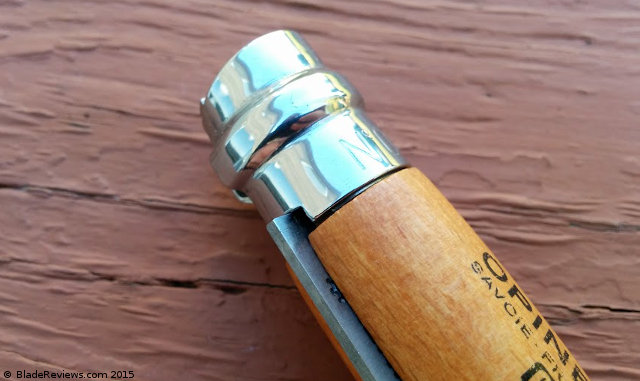
The No. 8’s blade comes out so smoothly, in fact, that I would feel uncomfortable using with without the Virobloc locking ring. This is a proprietary Opinel feature, and is basically a ring around the pivot collar of the knife that, when the knife is either opened or closed, can be rotated around until it meets up against the tang of the blade and locks it either open or closed.
I like the Virobloc a lot. As with deployment, locking it is a two-handed endeavor, but speed isn’t something you should come to the Opinel looking for. I can only guess how it would stack up in strength against other locks, because I’ve never had a lock of any sort fail on me, but if you use the No. 8 for the tasks it was designed for, I don’t think you’ll ever have any issue with the Virobloc.
One interesting historical note: there is a traditional opening method for the Opinel, called the Coup de Savoyard. You tap the beak of the Opinel’s handle on a table so the blade jumps out a bit, and then open it. Not any faster than just opening it normally, but undoubtedly classier.
Opinel No. 8 Review – Final Thoughts
The Opinel No. 8 is a great knife. It has one of the best blade shapes in the world, and a comfortable, attractive handle. The two major issues I have with it-the choice of steel and the bulky carry-can be addressed by getting a stainless steel model in a smaller size. But even as it stands, years after I first picked it up, and after a hundred other knives have passed through my hands, I still come back to the No. 8, and every time I do I am pleasantly surprised-although maybe I shouldn’t be; great design doesn’t get outmoded after all, and I think the No. 8 is one of the inarguable masterpieces of our hobby.
- XC90 CARBON STEEL BLADE: Extremely hard thereby ing excellent cutting quality, good wear resistance, and easy regrinding. Carbon steel can corrode easily, maintain your knife by avoiding damp locations, and wipe and grease the Blade after use
- FLAGSHIP SIZE: The Number 8 is the most sold and versatile size in the ever-growing line of Opinel folding pocket Knives, earning its reputation as an everyday carry staple. 3.35” blade (8.5cm), open length 7.5” (19.5cm)
- PATENTED VIROBLOC: A hallmark of Opinel everyday carry knives since its invention in 1955, the Virobloc ring offers a unique, thoughtful, and easy to use safety mechanism for locking the blade during use, during Transport, and during storage
- SUSTAINABLE BEECH HANDLE: Our selection of wood is precise and meets strict standards for social responsibility and the environment. We select beech wood from ecologically managed French woodlands in the Alpine region and Jura Mountains
- AN ICON OF FRENCH CULTURE: Produced in the heart of the French Alps since 1890, Opinel knives draw simplicity and durability from their mountain roots. Opinel kitchen knives have been adopted worldwide and recognized as a design Icon
If you are thinking of buying an Opinel knife, I please consider purchasing it at Amazon.com. Please consider that buying anything through any of the links on this website helps support BladeReviews.com, and keeps the site going. As always, any and all support is greatly appreciated. Thank you very much.
